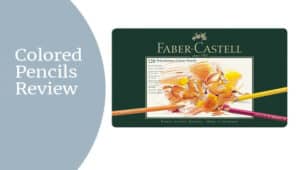
Buying colored pencils? Now you have a comprehensive guide.
In this article, I am going to share details of how I go about evaluating colored pencils. This will also provide an overview of the information you should be finding and expecting from a colored pencil review. Before I wrote this article, I pondered breaking content into smaller articles, which I did. But I still wanted a comprehensive resource you could return to over and over to assist you in evaluating and understanding colored pencils which I consider to be the most important tool/resource in adult coloring.
The following will are the key section headings in this article.
- Colored Pencil Purchase Decision Process
- Suggested Review Process for Colored Pencils
- What to Expect from Colored Pencil Reviews
- Oil-base vs. Waxed-based Pencil Core
- Softcore vs. Hardcore Colored Pencil Cores
- Colored Pencil Design and Pigment Quality
- Colored Pencil Construction
- Colored Pencil Purchase Decision
- Checkout Other Articles Resources
Over the years, I have had a chance to evaluate, purchase, and experience various colored pencils and coloring books. On ColoringButterfly.com, I write about adult coloring, including colored pencil reviews from the point of view of adult coloring in coloring books.
Buying Colored Pencils Guide
Table of Contents
- Colored Pencil Purchase Decision Process
- What to Expect from Colored Pencil Reviewers
- Suggested Review process for Colored Pencils
- What to Expect from Colored Pencil Reviews
- Oil-base vs. Waxed-based Pencil Core
- Softcore vs. Hardcore Colored Pencil Cores
- Colored Pencil Design and Pigment Quality
- Colored Pencil Construction
- Colored Pencil Purchase Decision
Other resources. Check out other supporting resources on ColoringButterfly.com that you might enjoy.
- Buying A Coloring Book: Everything You Need to Know (Guide)
- How to Find Colored Pencil Reviews (50+ ColoringButterfly.com)
- Guide to Using Colored Pencil Set Reviews (Step-by-Step)
- How to Find the Best Colored Pencil Paper for Coloring (Guide)
- Guide to Amazon Colored Pencil Reviews (Fake vs. Trustworthy)
- 9 Ways to Spot A Safe vs. Shady Amazon Third-party Seller
- How to Check New Colored Pencils for Damage (4 Easy Steps)
- How A Car Crash Gave Me the Gift of “Living in the Present”
Colored Pencil Purchase Decision Process

Many factors go into purchasing colored pencils, and this decision is among the most important in adult coloring. I remember when I bought my first set of colored pencils. I reviewed up to 10 pencil brands, read five or more reviews for each brand, and viewed many Amazon reviews. The more I looked, the more I hesitated and confused I felt. I ended up buying a cheap brand with lots of colors. That was a terrible choice. I quit coloring because I was not too fond of the pencil set and the coloring experience they gave me. I did not know there was a difference in pencils.
What to Expect from Colored Pencil Reviewers
There is a lot of discussion about which are the best-colored pencils. Perhaps this is your first review or your tenth review. When I started, I reviewed up to 10 pencil brands, read 5 or more reviews for each brand, and viewed many Amazon reviews. The more I looked, the more I hesitated. Perhaps you have the same experience. I would like to share some of the lessons I have learned from going through the colored pencil review process and purchase process 20-plus times. [TOC]
Suggestion on Which Reviews to Trust
Reviews come in the form of articles, videos and more. You can learn a lot from both types of reviews. Reviews are based on a reviewer’s skill base and experience. Reviewers can range from novice to professional artists. A reviewer’s point of view is valid because that is their experience. For example, some recommend Chevy or Ford, while others recommend Honda or Subaru. (I like Subaru.) I want reviews that are filled with information. Once you have read a few reviews, you will quickly understand what reviews to evaluate and which ones to ignore. I can go through 10 Google listings for pencil reviews in a couple of minutes once I get a sense of what is out there. Once I find a reviewer, blog or website I trust, I keep returning to them because I trust their experience. [TOC]
Sponsored vs. Non-sponsored Reviews
Should you view reviews from reviewers who are sponsored for the review or those who are not sponsored? That is an easy question. View both. Why, Colored pencil sets can get expensive, especially when reviewing more than just a few.
I am okay with reading a review from someone given the pencils. As a practice, these reviewers will tell you upfront that they were given the pencils to review or that their review includes affiliate links. All I want is expertise. They get the freebie; I get years of experience, which is a good trade-off.
In my case, I am not an artist. But I am an experienced adult who continues to love and grow in adult coloring. I have spent hundreds of hours using and reviewing pencils for my use, and I am sharing what I have learned. It’s my opinion. I hope you find value in the articles. [TOC]
Artist vs. Non-artist Reviews
I think there is a place for both types of reviews. It is important to remember that colored pencils are not just used for adult coloring. There are artists, designers, hobbyists, teachers, families and more who use and want to find the best-colored pencils to meet their needs. I want to make sure that at least 50% of the reviews I read have some or all their focus on the type of colored pencils use I will be doing. In my case, my reviews are meant for those who enjoy and want to make decisions for adult coloring in coloring books. [TOC]
Suggested Review Process for Colored Pencils

I like to read and view reviews about colored pencils, and I would like to share how I evaluate colored pencils, which includes reading and viewing.
Step 1: Google Search and Read Blog Articles
I like to start by reading about colored pencils. I start with articles written by experienced colorists and artists that list the top 5, 10 or more pencil sets and explain why. Some lists are best budget pencils to best expensive pencils. These articles help me narrow my focus. Next, I read articles that drill down into specific brands. Why do I read vs. view YouTube first? I can narrow my search to two or three choices in an hour or two.
- CAUTION: Stay away from reviews that are nothing more than lists of colored pencils with a link to an online store. Often these lists will have a list of the top 5, 10, or more. What is the list based on? I did not find them to be of any real value. [TOC]
Step 2: Google search and view YouTube
At this stage, I am focused on two or three brands. When deciding on videos to watch, look at the number of views and the year posted. I want to start with a video that is no older than three years and has 500 to several thousand views. When I view videos, I get to listen in on a conversation with someone who is taking the time to share their knowledge. I get a front seat to what is going on. Why do I view videos second and not first? Colored pencil video reviews can easily last 30 minutes, and I want to spend that time with my narrowed selection. [TOC]
Step 3: Amazon Reviews
Amazon reviews are essential; in these reviews, you get the experience of others. By this time, you have read and viewed enough about the pencil sets that you can better understand which reviews to listen to. [TOC]
What to Expect from Colored Pencil Reviews
As I have already shared, my colored pencils reviews are made from my personal experience and perspective as one who spends most of their time coloring books. When I write articles/reviews about colored pencils, I carefully consider and evaluate as much as I can about the pencils to help you make betters decisions. The following outlines the categories and elements I review when researching, testing, and evaluating colored pencils.
Student-grade vs. Artist-grade
When I evaluate colored pencils and want to know whether they are student-grade or artist/professional-grade, once I have this knowledge, I have a foundation of what to expect when evaluating the pencil set. Most brands of pencils will have varying grades of pencils.
- Student-grade. I expect the pencil core to be harder if it is a student-grade pencil. The formula for the core has more bonding agents than pigment, and colors will be less vibrant and fade over time. Student grade is used for learning colored pencil skills, and you will need to apply more pressure for better saturation. Rarely will you find student-grade pencils that have a lightfast rating. They are easier to erase, which helps in making corrections/adjustments. These are excellent starting points for beginners.
- Artist/Professional grade. Artist-grade pencils are usually oil-based and are more expensive. They are known for quality pigments, performance, and lightfast ratings are known for quality pigment. They are more fade-resistant and can be sharpened to a fine point. If they are softcore, they are great for blending, layering, and shading. This grade of a pencil will often have a lightfast rating which is the property of a colorant such as dye or pigment that describes how resistant to fading it is when exposed to light.
- Student-grade vs. Artist/Professional-grade for adult coloring. A variety of quality pencils in all price ranges provide exceptional coloring experiences. After coloring for a long time, I want quality student-grade and artist-grade pencils for my adult coloring. Of course, so many factors in your choices range from budget, the type of coloring themes you like and the type of paper. [TOC]
Oil-base vs. Waxed-based Pencil Core

I look carefully at whether the pencil core is wax- or oil-based. Each type of core has common characteristics, and pencil cores combine pigment, gum binder, wax or oil and filler material. Each colored pencil brand has unique formulas unique to the brands, and manufacturers will alter these formulas/recipes to create specific qualities for their pencils. This outlines my mental checklist when I evaluate how the pencil stands up to its features and attributes. [TOC]
Wax-based Colored Pencil Cores
The most common-colored pencils are wax-based cores. Wax-based cores contain varying amounts of pigments, additives, and binding agents. The following are a few characteristics of wax-based colored pencil cores. They include
- Smooth application. Wax-based has a tendency lay down smoothly. I look for descriptions that include words like creamy and buttery smooth.
- Rich color. Wax-based pencils use a wax binder which is usually softer and allows for rich color without excessive pressure.
- Wax bloom. When you layer a wax-based, you can get a milky film that can start to form. This substance comes from a type of binding agent that is used. Wax or oil buildup can occur to dimmish the color vibrancy. The best way to forgo wax bloom is to use lightfast colored pencils
- Sharpening. Softcore wax pencils require a softer touch when sharpening, and Lower-quality pencils can even break during sharpening. Look for pencil sharpeners that are designed for colored pencils.
- Blending and layering. The wax-based colored pencils can produce a buttery surface conducive to blending, layering and mixing.
- Keeping a sharp point. Softcore colored pencil tips will wear down quicker. The finer the point, the easier it is to break.
- Less use for detail. Because the core softness will not hold the point for long and make their application for detail work less desirable.
- Ease of blending. Blending is the ability to blur hard/sharp lines into softer tones. Each stroke leaves a heavier and tends to respond well to blender pencils and solvents (e.g., Gamsol, Zest-it) which helps to eliminate pencil strokes and make the colors smoother and more uniform.
- Less smearing. The wax-based core does not smear as easily.
- Erasable. Wax-based cores are easier to erase than oil-based pencils.
- Rare lightfastness rating. It is rare to find lightfastness ratings with wax-based cores. Lightfast rating is essential to artists, especially when they spend long hours creating art; they will want the work of art to keep its vibrancy for years to come.
- More set options. Manufacturers make many set options ranging from 12-count to 150-plus count pencil sets.
- Example of an excellent wax-based colored pencil. Today, many good wax-based colored pencils exist in all price ranges. The most common wax-based core many colorists have in their collection/resources is Prismacolor Premier colored pencils.
- Beginner friendly. They are more user-friendly for the beginner. They are considered ideal for layering, blending and shading.
- Lower price point. Wax-based core-colored pencils are less expensive to make. They are at a price point favorable to most beginners because of the softcore performance characteristics, such as those detailed above. They are more user-friendly for the beginner but come with a shorter life span due to heavier application with each stroke, more frequent sharpening, and breakage issues. [TOC]
Oil-based Colored Pencil Cores
Oil-based cores contain varying amounts of pigments, additives, and binding agents. The following are a few characteristics of oil-based colored pencil cores.
- More pigment. Oil-based pencils have more pigment and lay down with vibrant colors. The intensity of colors is richer and deeper with fewer layers.
- Application. Oil-based colored pencils lay down vibrant colors.
- Harder than the wax-based core. The hardcore pencils last longer, are known to be more durable and are less susceptible to breakage
- Layering. Oil-based can layer easily, and the core will lay down less color when applied to the paper but can give the user more control of color. Using pencils and solvents (e.g., Gamsol, Zest-it) helps to eliminate pencil strokes and make the colors smoother and more uniform.
- Softcore Layering. If the oil-based colored pencil has a softcore, you experience better layering than you would with a wax-based core.
- No blooming. Unlike wax-based pencils that can account for a bloom with layering, oil-based pencils will not bloom.
- Less susceptible to breakage. The harder core makes them less susceptible to breakage.
- Less erasable. Oil-based cores are not as easy to erase as wax-based colored pencils.
- Sharpening. Because of the core hardness, they are less prone to breakage during sharpening, and you can achieve a sharper point.
- Lightfastness. Many oil-based pencils come with a lightfastness rating. Lightfastness is a property of a colorant such as dye or pigment that describes how resistant to fading it is when exposed to light. Lightfast rating is essential to artists, especially when they spend long hours creating art; they will want the work of art to keep its vibrancy for years to come.
- Detail. Because pencils can be sharpened to a fine point, they are great for detail.
- Less set options. Manufacturers tend to have fewer set options.
- Higher price point. Oil-based pencils usually come with higher costs, such as those detailed above. Because of their hardness and overall characteristics, the pencils last longer.
- Example of a good oil-based colored pencil. Today, there is a plethora of good oil-based colored pencils in all price ranges. The most common oil-based core that many colorists have in their collection/resources is Faber Castell colored pencils. [TOC]
Softcore vs. Hardcore Colored Pencil Cores

I look at whether the colored pencil core is soft or hard. Pencil cores combine pigment, gum binder, wax or oil and filler material. Each colored pencil brand has unique formulas unique to the brands, and manufacturers will alter these formulas/recipes to create specific qualities for their pencils. For example, student-grade pencils tend to be harder, while professional-grade are known for superior quality and can be hard or soft. This has been my experience regarding softcore and hardcore attributes.
Softcore Attributes
Softcore colored pencils will quickly lay down and have the properties of being smooth and creamy. They are considered ideal for layering, blending and shading. When coloring, you can lay down layers without smearing. Depending on the grade, the softcore can tend to be more prone to breakage, being grainy and crumbly. The pencils are ideal for coloring and have vibrant colors. Softcore pencils tend to wear down faster, do not hold a point as hardcore, and need sharpening more often. The pencils can be lighter because they have more pigment.[TOC]
Hardcore Attributes
Hardcore pencils last longer and are known to be more durable. You will need to apply more pressure for better saturation. They can be sharpened to a fine point that will keep strong when pressed hard on the paper’s surface. They are less prone to crumble and breakage. They are excellent for detail work (e.g., outlining, small details, tight places) and realism, such as portraits, hair or animal fur. The hardcore colored pencils take more effort to apply color and blend. When coloring, you must be more careful not to press too hard; it can damage and tear the paper. They are easier to erase, which helps in making corrections/adjustments. [TOC]
Which is Best?
There is a place for both hardcore and softcore coloring pencils. In coloring, it is a good idea to consider having both hardcore and softcore so that you can address the needs of different coloring surfaces, themes, and detail. Softcore colored pencils are favorite for adult coloring (e.g., beginners, colorists) because they lay down more smoothly and deliver vibrant colors. Hardcore is excellent for detail and realism. Remember that hard and softcore pencils come in student to artist/professional grades. [TOC]
Colored Pencil Design and Pigment Quality
Colored pencil sets range vastly from student grade to professional grade with variations in design and quality.
How to Review Pigment Quality
The pigment will be the most significant difference contributing to quality and price, and more pigment means your colors will look fresh and vibrant or longer. When I test/review pigment, I look at elements like
- Vibrancy. Pigment concentration is the most significant contributing factor to color vibrancy. For example, some colored pencil sets require more layers and heavier strokes to achieve color brightness/depth, while others achieve the same lively colors with gentler/softer strokes.
- Application experience. I reviewed the experience I had when applying each stroke of color. Was the application of color smooth, creamy, scratchy or other?
- Response to types of coloring paper. I want to understand how the color looks when each stroke is applied to coloring book paper (e.g., Amazon-like to artist edition) during layering and blending without the aid of other substances (e.g., Blender Pencils, mineral spirits).
- Basic layering/blending. I look at how the pigment responded to layering and blending without assistance from tools (e.g., blender pencils, white pencils, Gamsol/Zest-it).
- Blending with pencils, solvents and more. I review how the pigment responds/breaks down to blender pencils (e.g., Prismacolor and Derwent blender pencils), burnishing, white pencils, blending stumps, solvents (e.g., Gamsol, Zest-it), blender pens and more.
- Comparison to similar categories. I review how the pigment compares to the categorization of the pencil (e.g., student grade, artist/professional grade). Artist-grade categorization usually means higher quality, and I expect the colors to be vibrant with each stroke. Another way to look at it is the price range (e.g., budget, average, expensive) category.
- Overall category comparison. I also look outside the category and see how the pigment/pencil compares to all other colored pencil brands, regardless of category classification. [TOC]
Color Variety
I carefully evaluate the variety of colors presented in the set. For example, an artist has the skill to take just a few colors and blend them into many more colors. Because I am focused on coloring books, I want to have the necessary colors to address my favorite coloring book themes. Since I am reviewing pencil sets on a broad basis, I ask myself questions like
- Does the pencil set have a good breath of color?
- Does the colored pencil set have a range of colors to address any coloring book theme (e.g., jungle, deserts, people, shapes, mandalas, flowers, animals, and mythical variations)? If not, what then?
- Do the pencil sets have too many of one color or not enough of another? [TOC]
Lightfastness
Lightfastness is a property of a colorant such as dye or pigment that describes how resistant to fading it is when exposed to light. Lightfast rating is essential to artists, especially when they spend long hours creating art; they will want the work of art to keep its vibrancy for years to come. Lightfast grading scales will vary by manufacturer. The most common scale I look for is the ASTM scale, the Blue Wool Scale and the Grey Scale. Some brands like Caran d’Ache have their own. Not all pencils in a set will have the same lightfastness rating. A lightfast rating can define how long a color will last. For example, a 1-star rating may mean a color will last for two years, while a 4-star can mean over a year.
I don’t necessarily care about lightfastness when coloring in coloring books. I care about lightfastness ratings if I want coloring pieces/artwork to stand the test of time, such as won’t fade, frame or sell your work. Many artist-grade colored pencils have a lightfastness rating and can be listed on the pencil shaft, packaging, or online. Suppose you want to save money by buying colored pencils; forgoing the lightfast will aid in reducing the cost. If lightfastness matters to you, carefully read the manufactures description and do your homework. [TOC]
Open Stock vs. No Open Stock
When a color in your pencil set becomes exhausted, can you purchase a replacement for the color? This is known as open stock. Student-grade pencil sets (e.g., Low-end to lower mid-range) are commonly not available in open stock, while artist/professional grade (e.g., higher mid-range to high-end) pencils have open stock. If I use artist-grade colored pencils, I want open stock; if it is student-grade, I usually don’t care about open stock. If a pencil from my colored pencils set becomes exhausted (used up), I can, for example, buy a new set, a smaller set of the brand that has the color, or chooses another color from the other 72-plus pencil sets or learn how to blend for the desired color. [TOC]
Colored Pencil Construction

Pencil cores combine pigment, gum binder, wax or oil and filler material encased in wood. The pencil construction can tell you a lot about the quality of the pencil. All colored pencils are not made equal. When evaluating a pencil, these are a few of the construction elements I look for:
Colored Pencil Cores. The most common colored pencil cores are either wax-based or oil-based. Pencil cores combine pigment, gum binder, wax or oil and filler.
- Pigments. The pigment will be the most significant difference contributing to quality and price, and pigment concentration is the most significant factor in color vibrancy. For example, some colored pencil sets require more layers and heavier strokes to achieve color brightness/depth, while others achieve the same lively colors with gentler/softer strokes.
- Binders. Binders/resins are property that binds/clues the pigment when mixed. Binders can range from paraffin wax to oily compounds. Binders significantly affect how colored pencil performs/interacts on varying types of paper.
- Extenders. Extenders and binders define the core’s firmness, and Extenders have a bearing on whether the colored pencil feels creamy and soft or firm and ridged. [TOC]
Colored Pencil Core Formula
Every manufacturer has its own formula/recipe for its colored pencils. Many manufacturers will have different types of pencil sets in their brand to address the needs of different coloring needs, price points, and types of artists/colorists. For example, Derwent has the following brands in its offerings: Derwent Couloursoft Pencils, Derwent Lightfast Colour Pencils, Derwent Procolour Pencils, and Derwent Studio Colored Pencils. When evaluating cores, it is essential to understand the type of characteristics the wax-based and oil-based provide for the coloring experience. When you read reviews, look closely at how the core performs with coloring, sharpening, and related tasks.
- Core/Lead Size. Most colored pencils have a core diameter between 3mm and 4mm. The large core diameter will contribute to how long the pencil will last.
- Wood. Wood is used to encase the colored pencil core, and higher-quality pencil casings are Cedarwood. Be on the lookout for words like “compressed wood.” Better quality woods are less likely to break with dropped or during sharpening. The wood quality can make all the difference in the pencil experience. When you read reviews, look closely at how the wood performs with coloring, sharpening, and related tasks.
- Round vs. hexagon pencil barrel. When it comes to round vs. hexagonal colored pencil barrel designs, there are pros and cons for each design. The round pencil barrels tend to roll when placed on uneven surfaces when bumped on a surface and can fall on the floor and break the lead. The hexagonal pencil, however, will stay in place without rolling.
I like the round barrels because they feel comfortable in my hands. When I use colored pencils, I will select the two or three colors I am working with and keep them out of the plastic tray or pencil case for easy access. My simple solution is to place the pencils in a temporary secure place (e.g., mug, small plastic tray, inside of the open case, inside tin lid of a pencil case). [TOC]
Performance with Paper
Colored pencils will respond differently to various types of paper, and I want to understand how the pencils perform with different types of paper. When I color, I like to match the pencil to the paper. Many colored pencils work well on all papers. Coloring books are usually not known for having quality paper. I want to ensure that the pencils I use will work well with my coloring books. For example, a more textured paper will wear down a tip faster but will hold more layers. In contrast, a smoother paper will save on the lead but will not hold as many layers. [TOC]
Colored Pencils and Other Mediums
This topic refers to the concept that you can mix colored pencils with other forms of coloring tools (media) for your adult coloring (e.g., graphite, markers, gel pens, watercolors, crayons, pastels, and gouache. I like using colored pencils and markers or gel pens; combining media can be fun when you are ready. If you are interested in this topic, many excellent YouTube articles cover these types of topics. [TOC]
Colored Pencil Purchase Decision

Many factors go into purchasing colored pencils, and this decision is among the most important in adult coloring.
I remember when I bought my first set of colored pencils. I reviewed up to 10 pencil brands, read 5 or more reviews for each brand, and viewed many Amazon reviews. The more I looked, the more I hesitated and confused I felt. I ended up buying a cheap brand with lots of colors. That was a terrible choice. I quit coloring because I was not too fond of the pencil set and the coloring experience they gave me. I did not know there was a difference in pencils. [TOC]
What Determines the Cost of Colored Pencils
The cost of colored pencils is based on various factors, including the formula and characteristics of the pencil core (e.g., wax-based, oil-based core), type of wood, lightfastness rating, durability, packaging design, and more. [TOC]
Cost and Availability
I will be using USD currency for this discussion. Colored pencil sets range vastly from student grade to professional grade. The prices can range from under $30.00 USD to several hundred USD. I look at the value of pencils compared to price/performance and availability. When I say price, I mean the amount charged on Amazon, DickBlick or local stores. The price per pencil is determined by taking the cost of the pencil set divided by the number of pencils (e.g., $49.00 divided by 120 pencils). Colored pencil sets are commonly placed into the following categories:
- Low-end/budget (Under .50 cents)
- Mid-range/average (.51 cents to $1.00 dollar)
- High-end/expensive and premium ($1.00-$2.00) [TOC]
How Much to Pay for Colored Pencils
I think it comes down to what type of coloring you want to do. If you are just starting and want to test the waters of coloring, there are several excellent pencils in the budget category for those pencil sets; I would suggest allowing up to $50.00 USD, and I went the route of “Cheap” less than $20.00 USD. Please don’t do it. The next level is $51.00 to $150.00 USD, and for that budget, you will find great sets and have a good experience with most of your coloring projects and coloring books. And if budget is not a concern, I would still suggest keeping your purchase in the mid-range. See the category “Cost and Availability” in this article. [TOC]
How Big of A Colored Pencil Set to Buy?
As you review and evaluate colored pencils, consider that many brands have multiple sets (number of pencils in a set) to choose from. Consider the following suggestions.
- Brand testing. If you have your eyes on a brand of pencils but still want to test them before you buy, purchase 3-5 open-stock pencils (if they have them) or a smaller set (12-24 pencils).
- Toe Dipping. If you are unsure that you want to get into adult coloring, I suggest starting with 48 to 72 pencil sets. You may move to a more extensive set if you want better low-end to mid-range sets. For many low-budget colored pencil sets, you may only have one set to choose from that have 150 pencils in the set.
- Adult Coloring is for Me. If you are sure you want to get into adult coloring, I am in favor of getting sets that range from 72 to 150 pencils in a set. You have a good color selection to cover most coloring book themes and projects. As time goes on, you may continue to add to your collection. That is what I have done. It’s not uncommon for me to use pencils from two sets in a project.
- Replacing Pencils in Pencil Set. When a color in your pencil set becomes exhausted, can you purchase a replacement for the color? This is known as open stock. Student-grade pencil sets (e.g., Low-end to lower mid-range) are commonly not available in open stock, while artist/professional grade (e.g., higher mid-range to high-end) pencils have open stock. If I use artist-grade colored pencils, I want open stock, and I don’t care about the open stock if I use lower-cost pencils. If a pencil from my colored pencils set becomes exhausted (used up), I can, for example, buy a new set, a smaller set of the brand that has the color, or chooses another color from the other 72-plus pencil sets or learn how to blend for the desired color. [TOC]
Where to Buy Colored Pencils
You buy pencils online or in your local community, and Online stores include resources like Amazon, DickBlick, JacksonsArt, JerrysArtarama and Aliexpress. Return policies vary.
Local community stores can include Hobby Lobby, Walmart, Target, Michaels and more. These stores will usually focus on selling lower-cost colored pencil sets that are wax-based. Return policies can be difficult and limited.
My favorite place to buy colored pencils is Amazon. I get good quality service and love the return policy (if needed.) [TOC]
If you like this article, please share it.






